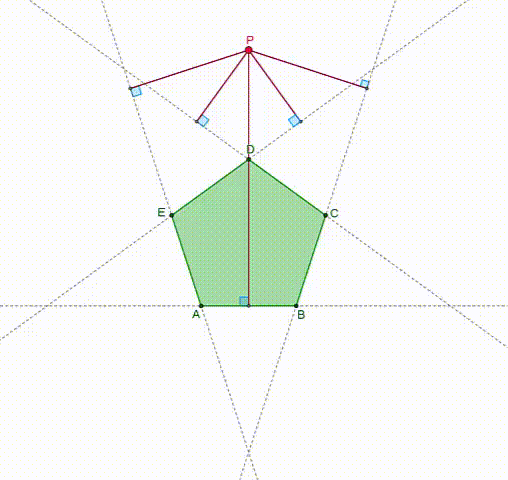-antastic sum of quadrances
 is a regular pentagon that can be inscribed in the unit circle.
is a point on the plane of the pentagon, with a peculiar property:
is a regular pentagon that can be inscribed in the unit circle.
is a point on the plane of the pentagon, with a peculiar property:
The sum of the squares of its distances from the sides of the pentagon is constant.
Prove that the locus of is a circle .
Given that the sum is , where is the golden ratio , find the radius of this circle and submit it as your answer.
Bonus:
Prove that the statement holds for any regular
-gon that can be inscribed in a circle of radius
and find a closed form for the radius of the locus , in terms of
,
and the constant sum of distances
.
The answer is 2.
This section requires Javascript.
You are seeing this because something didn't load right. We suggest you, (a) try
refreshing the page, (b) enabling javascript if it is disabled on your browser and,
finally, (c)
loading the
non-javascript version of this page
. We're sorry about the hassle.
The vertices of the pentagon are given by
P k = ( − sin ( 5 2 π k ) , cos ( 5 2 π k ) )
The outward normals of the sides of the pentagon passing through { P k } are given by
N k = ( − sin ( 5 ( 2 k + 1 ) π , cos ( 5 ( 2 k + 1 ) π ) )
Using polar coordinates, we can write P = ( r cos t , r sin t )
The distance between P and the k -th side is given by
d k = N k ⋅ ( P − P k ) = ( − sin ( 5 ( 2 k + 1 ) π ) , cos ( 5 ( 2 k + 1 ) π ) ) ⋅ ( r cos t + sin ( 5 2 π k ) , r sin t − cos ( 5 2 π k ) )
Expanding the above expression
d k = − r cos t sin ( 5 ( 2 k + 1 ) π ) + r sin t cos ( 5 2 π k ) − cos ( 5 π )
Simplifying further, this becomes
d k = r sin ( t − 5 ( 2 k + 1 ) π ) − cos ( 5 π )
So that the square of the distance d k is given by
d k 2 = r 2 sin 2 ( t − 5 ( 2 k + 1 ) π ) − 2 r cos ( 5 π ) sin ( t − 5 ( 2 k + 1 ) π ) + cos 2 ( 5 π )
Simplifying this further, it becomes,
d k 2 = r 2 ( 2 1 − 2 1 cos ( 2 t − 5 ( 4 k + 2 ) π ) − 2 r cos ( 5 π ) sin ( t − 5 ( 2 k + 1 ) π ) + cos 2 ( 5 π )
Adding all 5 of the squared distances { d k 2 } and noting that
k = 0 ∑ 4 sin ( τ + 5 2 π k ) = 0
and that,
k = 0 ∑ 4 cos ( τ + 5 4 π k ) = 0 Hence, the required sum of squared distances reduces to,
k = 0 ∑ 4 d k 2 = 2 5 r 2 + 5 cos 2 ( 5 π )
And this means that the sum is a function of the distance of point P from the origin. Thus the locus of constant sum points is a circle of radius r .
Finally, if the sum equals 1 0 + 4 5 φ 2 , then
2 5 r 2 + 5 cos 2 ( 5 π ) = 1 0 + 4 5 φ 2
which solves to r = 2 .